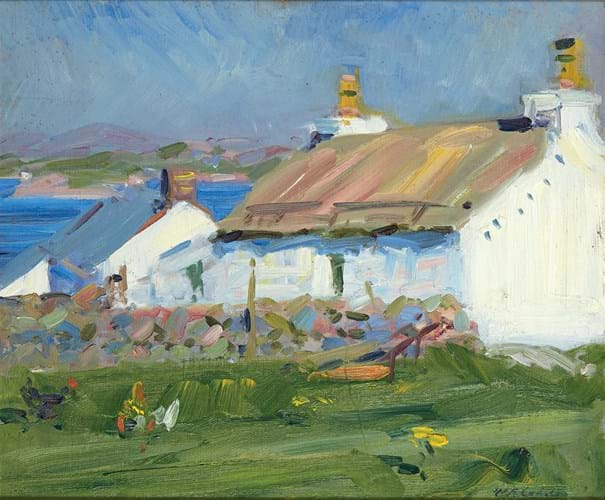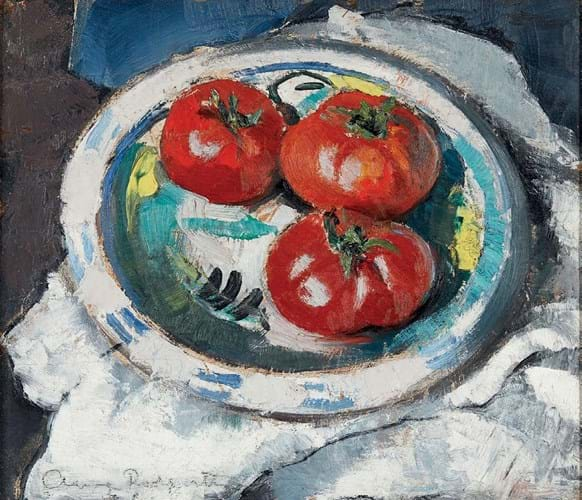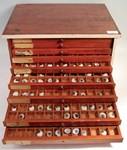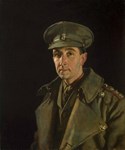Similar to the trend at art sales in Ireland, domestic bidding from private buyers is underpinning demand in Scotland.
Edinburgh auction house Lyon & Turnbull (25/20% buyer’s premium) reported “more home-grown bidding than we are used to” with just four lots selling to the trade in its sale of 19th and 20th century Scottish art on December 5.
Held a week before the General Election, the 167-lot sale posted a respectable £903,000 hammer total with 83% of lots going to new owners.
The total would have been greater had the sale’s highest-valued lots got away: a still-life estimated at £150,000-200,000 by Scottish Colourist Samuel Peploe and a landscape with hopes of £70,000-100,000 by fellow Colourist JD Fergusson.
“Overall we were pleased,” said Nick Curnow, vice chairman at L&T. “It was a much bigger sale than we usually have and there were some fairly meaty prices at £50,000-60,000.”
Of the high-flying casualties, he said there had been “no suggestion after the sale that they weren’t the right estimate”, rather that people were being “a little cautious” at the top level. “Whether the election a week later had anything to do with it, I don’t know, but it certainly did not seem to affect the rest of the sale,” he added.
The Colourists are the financial drivers of the Scottish art market. The progressive quartet of painters – Samuel Peploe, JD Fergusson, FCB Cadell and George Leslie Hunter – played a key role in the development of Modernism in the early 20th century, united by their preference for vivid colour and fluid handling of paint.
L&T states it has sold 90% of all art by the group offered in the last eight years – an indication of the demand in private collections for their work.
Landscape and flowers
Even with the major lots unsold, Colourist works still topped the Edinburgh sale. A landscape of the west-coast isle of Iona by FCB Cadell (1883-1937) and a flower still-life by George Leslie Hunter (1877-1931) – both in oils and relatively fresh to the market – were pursued beyond pre-sale hopes to top the price list. They sold for £64,000 apiece to different private buyers.
Cadell, the youngest and most versatile painter of the group, had a long-standing love affair with Iona and spent many a long Scottish summer painting there with Peploe.
In Crofts, Iona, Cadell captures a bright and breezy view with layer upon layer of light brushstrokes.
Curnow described the 14in x 17in (35.5 x 43cm) picture as “fresh, cheerful and positive” and a “really strong early work by Cadell”. The artist’s early pictures tend to be less commercial and this was reflected in the work’s conservative £30,000-50,000 guide.
Estimated at £40,000-60,000, the 18 x 16in (46 x 41cm) Still life with Marigolds by Hunter showed the influence of the French Fauves in its vibrant palette and energetic brushstrokes. It came from a private source and sold to a private collector.
The top-selling Peploe was a rare portrait passed by descent from one of the artist’s friends. Late in date, it depicts a young woman in a black hat against a coral background, suggested in the catalogue note as resembling Poppy Low, an artist’s model popular in Edinburgh in the 1920s. This enigmatic fresh-to-market offering, executed in typical Colourist hues, was taken to £36,000 against a £20,000-30,000 estimate.
The so-called ‘Fifth Colourist’, John MacLauchlan Milne (1886-1957), was inspired by the colours and the light that he encountered during his travels in Europe. Like so many painters, it was in 1920s Paris where he produced some of his most sought-after work.
Three trademark Parisian scenes depicting the bohemian world of the city’s café culture came from two sources and sold to separate buyers.
The most expensive, a 10 x 14in (25 x 36cm) scene showing a bustling café with fashionable Parisian clientele in the mould of his better-known Scottish predecessors, Peploe and Fergusson, took £34,000 (£30,000-40,000 estimate) while Boats on the Seine made £24,000 (£20,000-30,000) and Promenade, a scene of The Tuileries Gardens, fetched £22,000 (£20,000-30,000).
Over to Glasgow
The loose group of young artists known as ‘The Glasgow Boys’ are the other prominent group in the Scottish painting canon and represent the beginnings of Modernism in Scottish painting.
A winning bid of £26,000 secured a portrait of a grinning girl in wide-brimmed straw sunhat painted in 1891 by ‘Glasgow Boy’ George Henry (1858-1943) when he was at the height of his artistic career. A possible Royal Scottish Academy exhibit and notable for its technical quality and rich and decorative colour, the 20 x 18in (51 x 46cm) oil on canvas had been estimated at £10,000-15,000.
Two dramatic depictions of 19th century Scottish coastal life by the self-taught painter Sam Bough (1822-78) made decent money.
The larger of the two depicting the unloading of a catch at Newhaven harbour near Edinburgh was taken to £26,000 (£15,000-20,000 estimate). The smaller oil of an incoming storm at Newhaven made £16,000 (£10,000-15,000 estimate). “Scottish Victorian pictures are difficult, just like anywhere, so it was nice to get two traditional pictures away at sensible prices,” said Curnow.
Female artists were led by Anne Redpath (1895-1965), with all seven works by the Edinburgh College of Art student getting away.
The pick of them was an Impressionist-inspired still-life of three tomatoes in a bowl. Its rather untypical subject chimed with several bidders who pursued it to £13,000, over double the bottom guide.
Two of Joan Eardley’s (1921-63) popular pastel portraits of Glasgow’s working-class children sold above estimates at £9000 and £10,000.

















